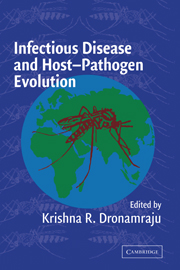Book contents
- Frontmatter
- Contents
- List of Contributors
- Introduction
- PART ONE J. B. S. HALDANE
- PART TWO MALARIAL PARASITES
- 3 Evolutionary Genetics of Plasmodium falciparum, the Agent of Malignant Malaria
- 4 Evolutionary Biology of Malarial Parasites
- 5 G6PD Deficiency and Malarial Resistance in Humans: Insights from Evolutionary Genetic Analyses
- 6 The Enigma of Plasmodium vivax Malaria and Erythrocyte Duffy Negativity
- PART THREE OTHER PARASITES
- PART FOUR GENETIC AND EVOLUTIONARY CONSIDERATIONS
- Index
- Plate Section
- References
4 - Evolutionary Biology of Malarial Parasites
Published online by Cambridge University Press: 10 August 2009
- Frontmatter
- Contents
- List of Contributors
- Introduction
- PART ONE J. B. S. HALDANE
- PART TWO MALARIAL PARASITES
- 3 Evolutionary Genetics of Plasmodium falciparum, the Agent of Malignant Malaria
- 4 Evolutionary Biology of Malarial Parasites
- 5 G6PD Deficiency and Malarial Resistance in Humans: Insights from Evolutionary Genetic Analyses
- 6 The Enigma of Plasmodium vivax Malaria and Erythrocyte Duffy Negativity
- PART THREE OTHER PARASITES
- PART FOUR GENETIC AND EVOLUTIONARY CONSIDERATIONS
- Index
- Plate Section
- References
Summary
INTRODUCTION
Analysis of Plasmodium spp. genome sequences would allow for the discovery of thousands of new genes and proteins, providing a unique opportunity for understanding the complex biology of malarial parasites. However, the identification of these new genes will be followed by the same old questions that researchers have faced for nearly three decades: how variable are the newly identified genes? How is such variation generated and maintained? How can this diversity affect intervention efforts?
Understanding the origin and extent of malarial parasites' genetic diversity, and the implications of these on the development of new intervention strategies, requires a close collaboration between biomedical researchers and evolutionary biologists. In the case of malaria research, as is the case in the study of many other infectious diseases, biomedical researchers/public health professionals and evolutionary biologists have traditionally worked in isolation.
Biomedical researchers and public health managers often seek answers to the following questions: What are the specific clinical end points in malaria? What level of efficacy can be expected from a multivalent vaccine? How does drug-resistance emerge? How quickly do drug-resistant parasites disperse? What is the impact of transmission pressure on the dispersal of drug-resistant parasites? Is it better to use one drug at a time or to use a “cocktail” before any of the drugs become ineffective? What is the impact of bed-nets on the selection of parasite lines?
- Type
- Chapter
- Information
- Infectious Disease and Host-Pathogen Evolution , pp. 75 - 112Publisher: Cambridge University PressPrint publication year: 2004



